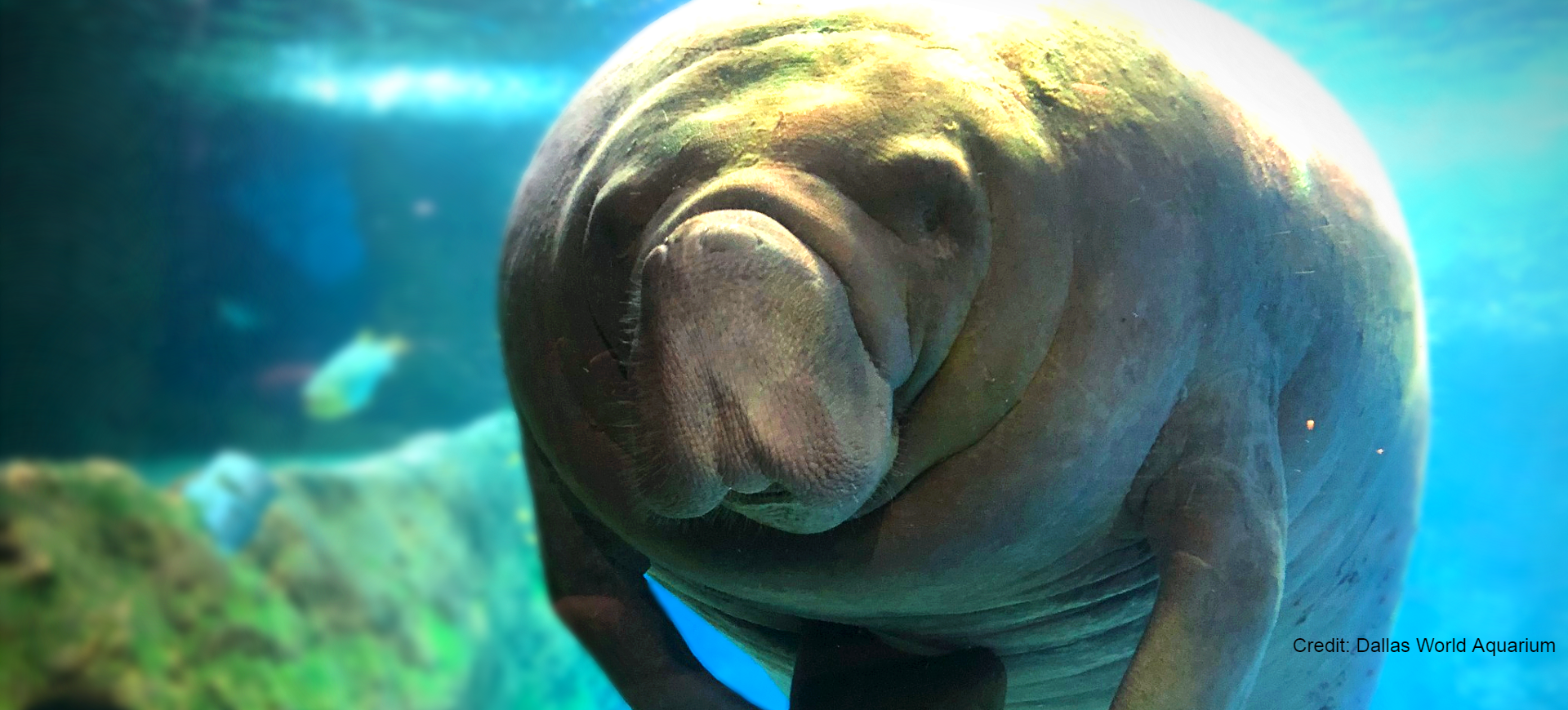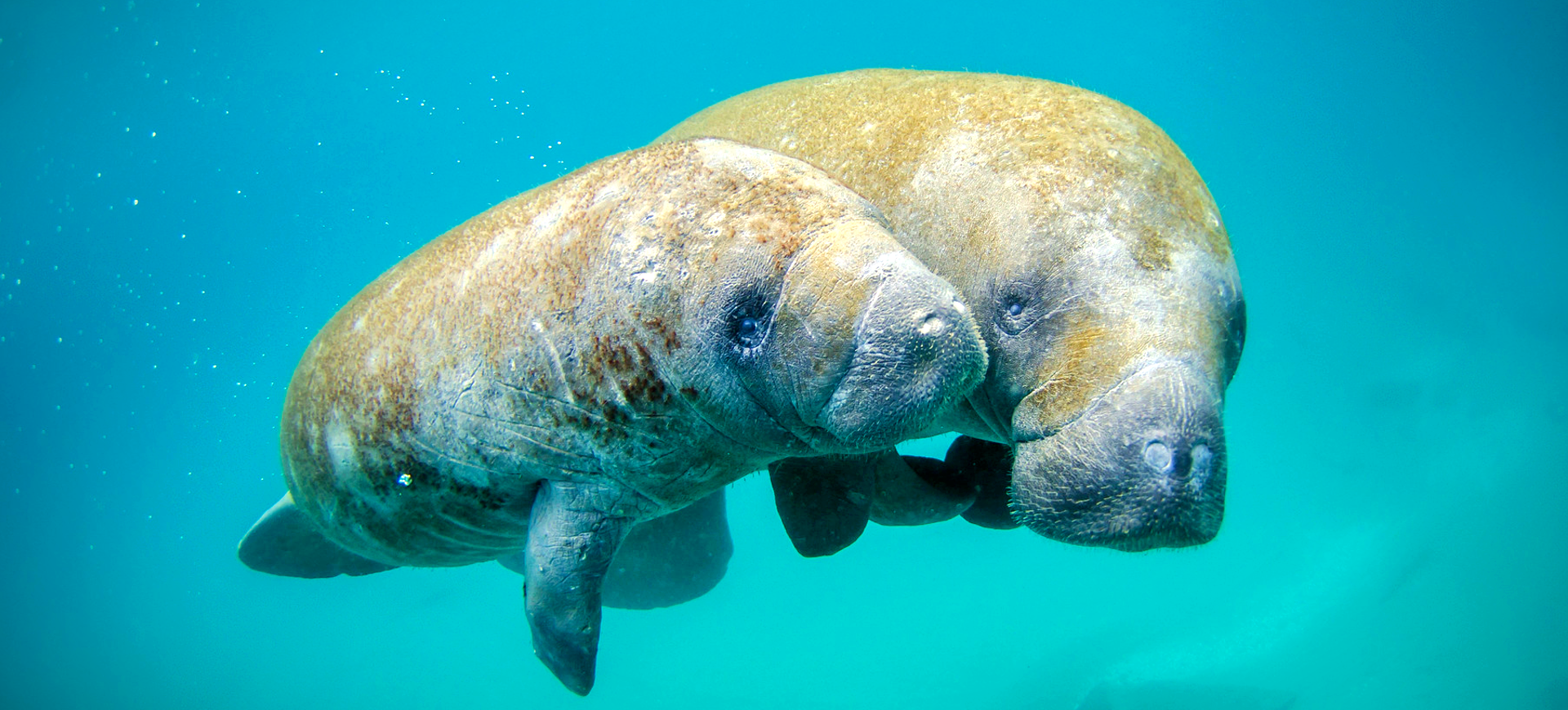Overview
The West Indian Manatee, scientifically known as Trichechus manatus, is a gentle giant of the Caribbean and adjacent Atlantic coasts. This aquatic mammal is characterized by its large, elongated body, which is grayish-brown, with a distinctive paddle-shaped tail that aids in propulsion through the water. Manatees possess a pair of flippers that are used for maneuvering and bringing vegetation to their mouths, as they are herbivores, feeding primarily on a variety of submerged and floating plants.
The West Indian Manatee is divided into two subspecies: the Florida manatee (Trichechus manatus latirostris) and the Antillean manatee (Trichechus manatus manatus), each adapted to their specific environments within the species’ range. These creatures are known for their slow-moving and peaceful nature, often grazing in shallow, warm waters. Despite their large size, manatees are graceful swimmers, capable of using their flippers to walk along the bottom of their aquatic habitats.
Conservation efforts have been crucial for the West Indian Manatee, as they face threats from habitat loss, water pollution, and collisions with watercraft. Their slow reproductive rate, with females typically giving birth to only one calf every two to five years, makes population recovery slow. Protection measures, including speed restrictions for boats in manatee habitats and conservation of warm-water refuges, have been implemented to aid in the recovery of manatee populations.
Taxonomy
Kingdom
Phylum
Class
Order
Family
Genus
Species
Sub Species
Type
Physical Description:
West Indian Manatees are large, typically measuring between 9 and 10 feet in length and weighing around 800 to 1,200 pounds, although some individuals can weigh as much as 3,000 pounds. Their bodies are spindle-shaped, which aids in their aquatic lifestyle, and their skin is thick and wrinkled, often covered in algae, which can give them a greenish appearance. Their faces are characterized by a whiskered snout, which is highly sensitive and used to explore their environment and locate food.
These marine mammals have small eyes and no external ear flaps, yet they have keen senses of sight and hearing underwater. The flippers of the West Indian Manatee are used for steering and manipulation, while their strong, flat tail power their slow but steady movement through the water. Despite their bulky appearance, manatees are capable of agile maneuvers and can swim backward or turn in tight circles with ease.

Lifespan: Wild: ~40 Years || Captivity: ~60 Years

Weight: Male: 1,200-3,000 lbs (540-1,360 kg) || Female: 800-1,200 lbs (360-540 kg)

Length: Male: 120-156 inches (304-396 cm) || Female: 108-120 inches (274-304 cm)

Top Speed: 20 mph (32 km/h)
Characteristic:
Native Habitat:
The West Indian Manatee inhabits the shallow coastal areas, rivers, and estuaries of the southeastern United States, the Caribbean, and Central and South America. Their range extends from the southeastern United States down to the northeast coast of Brazil, including the Gulf of Mexico, the Caribbean Sea, and the Amazon Basin. These environments provide the warm, shallow waters that manatees prefer, with abundant vegetation for feeding.
Manatees depend on warm water for survival and seek natural warm-water springs or power plant discharges during colder months to maintain their body temperature. Their habitat preferences make them vulnerable to environmental changes, including water pollution, habitat destruction, and the impacts of climate change, which can alter the availability of their food sources and warm-water refuges.
Biomes:
WWF Biomes:
Biogeographical Realms:
Continents:
Countries:
Diet:
Diet & Feeding Habits:
The West Indian Manatee is an herbivore, feeding primarily on various submerged, emergent, and floating plants in freshwater and saltwater environments. Their diet includes over 60 plant species, varying preferences by location and availability. Manatees consume about 4-9% of their body weight in vegetation daily, requiring them to graze for up to seven hours daily to meet their nutritional needs.
Manatees have adapted to feed in shallow waters, where they can often be seen using their flippers to walk along the bottom, grazing as they go. They have a prehensile upper lip split into two, which they use to grasp vegetation, pull it into their mouths, and manipulate food. This specialized feeding behavior is crucial for their survival, allowing them to access various aquatic plants across their habitats.
Mating Behavior:
Mating Description:
West Indian Manatees have a polygynous mating system, where one male mates with multiple females. Mating herds form during the breeding season, consisting of one female and multiple males competing to mate. These herds can be observed as groups of manatees engaging in active chases and displays in the water.
Females give birth to a single calf after a gestation period of about 12 to 14 months. Calves are born in the water and can swim to the surface to breathe within minutes of birth. The mother-calf bond is strong, with calves typically staying with their mothers for 1-2 years; during this time, they learn essential survival skills, including feeding and migration routes. The long dependence of calves on their mothers contributes to the slow reproductive rate of the species.
Reproduction Season:
Birth Type:
Pregnancy Duration:
Female Name:
Male Name:
Baby Name:
Social Structure Description:
West Indian Manatees are generally solitary but are known to form groups, particularly in warm-water refuges during the winter or in areas with abundant food sources. Social interactions are more common during the mating season when manatees gather in mating herds. Mother-calf pairs exhibit strong bonds, with calves depending on their mothers for up to two years.
Manatees communicate through various vocalizations used for social interaction and during mother-calf interactions. Understanding manatees’ social structure and behaviors is important for their conservation, as it influences their habitat needs and responses to environmental changes.
Groups:
Conservation Status:
Population Trend:
The population of the West Indian Manatee is difficult to estimate accurately due to their wide distribution and the challenges of surveying their aquatic habitats. However, conservation efforts and protective measures have contributed to population increases in some areas. The species remains classified as Vulnerable due to ongoing threats from habitat loss, water pollution, and collisions with watercraft.
Efforts to protect manatee populations include establishing speed restrictions in manatee habitats, creating protected areas, and public education campaigns to raise awareness of the threats facing manatees. Rehabilitation programs for injured manatees also play a crucial role in conservation efforts, helping to treat and release individuals back into the wild.
Population Threats:
West Indian Manatees face several significant threats, including collisions with watercraft, which can cause serious injuries or death. Habitat loss due to coastal development, pollution, and entanglement in fishing gear also pose risks to manatee populations. Additionally, the loss of warm-water habitats essential for their survival during colder months is a concern, particularly in the face of climate change.
Water pollution, including runoff from agriculture and urban areas, can lead to algal blooms that reduce the availability of aquatic vegetation, manatees’ primary food source. These cumulative threats require ongoing conservation efforts to mitigate their impacts and ensure the survival of the West Indian Manatee.
Conservation Efforts:
Conservation efforts for the West Indian Manatee include legal protections, such as the designation of the species under the Endangered Species Act in the United States and similar protections in other countries within its range. Establishing manatee sanctuaries and protected areas, speed restrictions for boats in manatee habitats, and public education campaigns are key components of these conservation strategies.
Rehabilitation centers for injured manatees provide care and treatment to release them back into the wild. Research and monitoring programs are essential for understanding manatee behavior, population trends, and the effectiveness of conservation measures. Collaboration between governments, conservation organizations, and local communities is crucial for successfully conserving the West Indian Manatee.
Additional Resources:
Fun Facts
- Manatees are known as “sea cows” due to their herbivorous diet and slow-moving nature.
- They can consume up to 10% of their body weight in vegetation daily.
- Manatees have no natural predators and are only threatened by human activities.
- They must surface every 3-5 minutes to breathe but can hold their breath for up to 20 minutes while resting.
- Manatees have a unique feature among mammals: they continuously replace their teeth from the back as they wear down in the front.
- Despite their size, manatees can execute tight turns and roll over completely underwater.
- Their closest living relatives are elephants and hyraxes.
- Manatees have used their flippers to “walk” along the bottom of their aquatic habitats.
- The West Indian Manatee has a very low metabolic rate and no undercoat, so they seek warm waters.
- They can understand discrimination tasks and show signs of long-term memory, indicating a higher level of intelligence.










